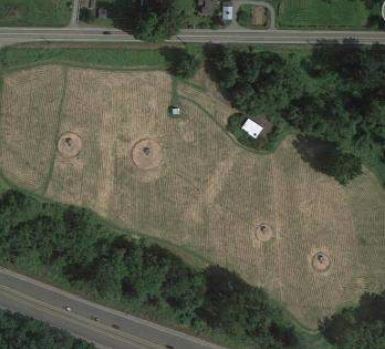Circular Fences in an AM Array

[April 2013] Most every AM station has a fence surrounding the base of each tower. And it seems like vast majority of these fences are square. However, Clay Freinwald decided to take on convention with a different shape.
Some years ago, I was given the job to construct a new four-tower AM Array in Auburn, WA.
Fence Planning
When it came time to figure out where to put the tower fences, I consulted the FCC’s OST-65 bulletin to determine the distances each of the fences needed to be from the towers. That way, the RF levels would be legal and not nuke the neighbors or any other critters that might wander by.
The usual method has always been to calculate the correct distance based on the radiated power, add a little for a safety margin, then square it off and build the fence around the tower.
Nevertheless, I never understood why they were all square. Apparently years and years ago someone had decreed this was the proper shape.
I noted that the Feds spoke in terms of distances to the “protection” fence and I got to thinking: “Why not make the fences shaped like a circle rather than the conventional square shape that we all have seen.”
By the time we got done, we ended up with four round fences of different sizes, confident that we were preventing high RF exposure outside the fences.

This fence is essentially a circle
In the interest of being completely accurate, by looking closely at the picture you can see that it is not a perfect circle in that the top-rail between posts is indeed straight.
Call it a slightly-squared circle.
A Different Shape
There are some unique considerations when building these that the average chain-link fence outfit is likely to not understand – probably because not many folks ask for them.
In a round fence system, you must have a top rail and, depending on your ground conditions, a bottom rail. This keeps the fence from collapsing inward. Perhaps the best way to understand the concept is to think of a barrel stay or the metal gizmo that keeps an old fashioned barrel round. In fence lingo this is the “top rail.”
Then you need the tension wire, to keep it from going the other way, both at the top and bottom. In some cases, I have used a turnbuckle to keep the circle snug.
So what does it look like?

All in all, it works quite well. This site has been in use with round fences for years now, and has proved the concept to the point that I would certainly do it again.
Shape-Related Challenges
At another site where I installed circular fencing, the ground is very wet (cat-tails, butter cups, and muck).
When it came time to install this fence I recall the contractor showing up with bags of concrete, gravel etc ready to do a conventional fence. However, in this location on such a muddy site a conventional square fence would not have worked for a number of reasons. Any attempt at a standard fence would have required huge poles dug deep into the ground.
On the other hand, for this site a circular fence was just what the doctor ordered. Rather than digging holes in the muck for every post, we did this for just a couple to keep the fence from moving around the array. Then the fence was built as a unit and simply set on top of the ground. It came out perfectly.
If you have questions on the process, required parts, or would like more pictures, drop me a note.
– – –
Clay Freinwald has been engineering in the Seattle area for approaching 52 years, caring for everything from studios to high-powered AM and FM transmitting plants.
You can email Clay at k7cr@blarg.net
